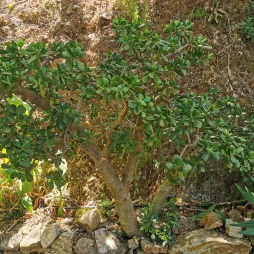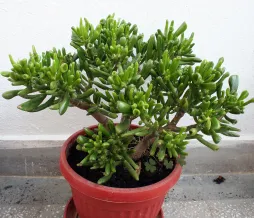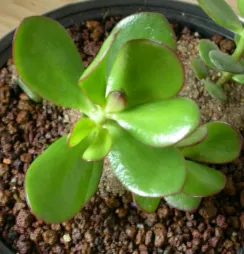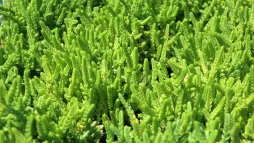Crassula arborescens, a shrub with gray leaves
Often confused with crassula ovata, Crassula arborescens also belongs to the Crassulaceae family and also comes to us from South Africa. It is distinguished, however, by its blue-grey foliage.
How to recognize Crassula arborescens?
Crassula arborescens is a succulent shrub with an upright, bushy habit. In the wild, it can grow up to four meters tall. However, in pots and indoors, it rarely exceeds one metre in height, with a spread of 80 centimetres.
Its thick, grey-green stem is highly branched. Over time, it lignifies and eventually forms a true brown, hairless trunk.
The branches are home to fleshy, opposite leaves. Oval, almost triangular, the leaf blades are green tinged with blue or gray. Leaf margins turn red when the plant receives sufficient sunlight.
Crassula arborescens flowers in winter. Pale pink flowers bloom in umbels at the ends of branches.
The plant is toxic to animals, especially cats, and to humans. When ingested, the leaves cause mucous membrane irritation and digestive disorders.
Our maintenance tips
Your Crassula arborescens needs only two things: abundant watering and plenty of light. Don't hesitate to take your plant outside in summer to enjoy the sunny days!
Watering
Water only when the soil has completely dried out. Use room-temperature water with low calcium content, such as rainwater.
Water generously to allow the leaves to soak up the water. Make sure any excess water has drained away before replacing your Crassula arborescens. If necessary, remove any water that has accumulated in the saucer or planter.
Spray
Crassula arborescens grow in arid regions and do not like humidity. No need to spray them.
Repotting
In spring, transfer your Crassula arborescens to a larger pot, so that it can continue to grow.
Choose a pierced pot and line the bottom with a layer of clay balls or gravel.
Then pour in a draining substrate, such as potting soil for cacti and succulents, or potting soil for green plants enhanced with sand and perlite.
Plant your Crassula arborescens and add substrate if necessary. Water to remove air bubbles and encourage rooting.
Fertilization
You can stimulate the development of your plant during its growth phase, in spring and summer, with fertilizer.
You can feed your Crassula arborescens with a fertilizer for cacti and succulents.
Cleaning
Over time, dust accumulates on the leaves, slowing down photosynthesis. To remove it, clean the foliage with a clean, damp sponge.
Prune
Remove dried leaves and flowers.
If you want to control the shape and development of your Crassula arborescens, cut back branches that have become too long under one eye.
Use a clean instrument, such as pruning shears or scissors, to prevent the spread of disease.
Use a clean instrument, such as pruning shears or scissors, to prevent the spread of disease.
Plantation
Once the last spring frosts have passed, you can plant.
Where's the best place to plant your Crassula arborescens? A sunny spot at the top of a slope, to encourage rainwater drainage.
Dig a large hole to give the roots room to spread out. As for repotting, place a layer of gravel at the bottom, followed by a layer of substrate. Place your plant in the center and cover with soil, possibly enriched with leaf compost. Press down to eliminate air pockets and water.
Cutting
Cutting is carried out during the strong growth phase, generally in spring and early summer.
Using a clean, sharp tool, remove a ten-centimeter section of stem.
Leave it to dry for 48 hours to prevent any risk of rotting.
Leave it to dry for 48 hours to prevent any risk of rotting.
In a pierced terracotta pot, pour a bed of clay balls or gravel to optimize drainage.
Prepare a mixture of one-third potting soil, one-third garden soil and one-third sand. Pour it into your pot, on top of the drainage layer. Plant your cutting and tamp it down.
Place the pot in a room where the temperature is always above 18 degrees. The location should be bright and out of direct sunlight. You can, for example, place your cutting behind a curtained window.
To avoid drowning the roots, always check the condition of the substrate before watering: the surface must be dry.
Disease / Threat
Information
| Family | Crassulaceae - Crassulaceae |
| Type | Crassula - Crassula |
| Species | Crassula arborescens - Crassula arborescens |
| Lifecycle | Perennial |
| Foliage | Evergreen |
| Exposures | |
| Substrat | |
| Planting methods |
Open ground In pots |
| Categories | |
| Origin |
South Africa |
| Hardiness (USDA) | 11a |
| Leaf color |
|
| Flower colors |
|
Discover plants from the same family

Jade tree
Discover

Crassula ovata 'Hobbit
Discover

Crassula ovata 'Minor
Discover

Crassula muscosa
Discover




















